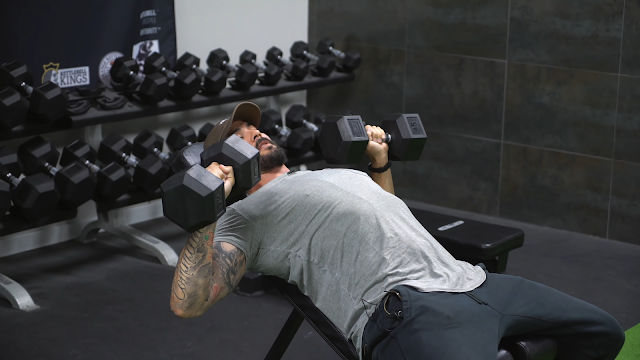Let's start off with the angle of the bench press. So you'll see some gyms, that have a fixed incline. Then you have some benches like the one I'm on right here that's adjustable. The higher you go up so as you start to increase the incline, the more shoulder recruitment that you're going to get. So if you're somebody who's trying to build the upper chest and maybe your shoulder caps going up really steep on an incline.
If you're not,
if you don't want a lot of your shoulders involved, you're gonna go lower. So
the lower you go towards the flat, the more chest is involved. The higher you
go up, the more of your shoulders are involved. When you start off with
dumbbells, they're independent and this can be really challenging for people.
So you want to start off with a lightweight that you can control. So we're
going to start off. For me, this is 45 pound This is really light. I should be
able to do somewhere between 120-pound dumbbells. So for demo.
Reasons. I'm
gonna start with lightweight. Then you want to find your points of contact,
which are just like a normal flat bench press. You've got your four major
points of contact, which are your feet you want planted firmly on the ground,
which is gonna be underneath your knees. Then you have your butt and hips,
which are going to be on the bench, your upper back, and then your head. So
when I lie back into that position to grab, get in that position to press. I
want my feet planted firmly on the ground because I'm getting a lot of leg
drive to press. I want my butt against the bench, I want my upper back and then
I want my head.
And then once I
get into this position, the next thing that I want to make sure that retract my
shoulders back. This is gonna be one of the most important cues because people
that struggle with doing a dumbbell press or a chest press or any chest press
for that matter is they have a problem with keeping their shoulders peeled
back. And in order for you to keep it in your chest and not it kick into your
shoulders and arms, we need to keep them peeled back. So shoulders are peeled
back, and the chest is up high. But as it gets bench you're going to have a
natural.
Arch in your low back. That's totally normal. You don't wanna excessively arch where you can feel it in your low back. You want a comfortable arch because you're raising your chest up and you're squeezing your shoulder blades back. Alright, so let's talk about how we get up into the position to do a dumbbell press. So a lot of people actually neglect even discussing this. What I want to do is want the dumbbells to starting off in front of me. I'm already in my seated position. I'm going to reach down with support. I have support on one side I pick up, and get that dumbbell up on one thigh.
Pick the other
one up on the other thigh. Now from this position, I'm gonna kick the dumbbell
up. I use my legs to kind of throw it up into this position. And the reason why
I want to do that is I want to keep the dumbbells close to my body. So when I
lay back down, they don't want to dip away from me. So a lot of times you'll
see people, they'll lay back and they'll open up their arms and the dumbbells
want to fly to their side and that's how you tear shoulder. So I wanna kick up,
kick up close, and then I lie back. Now, what's great about the path.
That you take
with a dumbbell is the dumbbells are you can actually mold to your posture and
your form, which is gonna be uniquely different to each person. So I don't
wanna flare my elbows way out. I don't need to bring the elbows away in. It's
going to be very comfortable for me. So I'm gonna have a nice about a 45-degree
bend in the elbows. Notice my dumbbells when I come down, they should be about
90 degrees. So when I come down to 90 degrees the dumbbells don't want to. You
don't want to weigh in and you don't want to weigh out, so you want to write it
with my elbow. You should see about a 90-degree bend.
I press all the
way up, keeping a slight bend in the elbow. Still. I don't wanna lock the
joints out. If I lock the joint out, that's also gonna roll my shoulders
forward. So I want to keep those shoulders pee back, slight bend in my elbows
come right back down. So I have about a 90-degree bend in my elbows. And then I
press up and I want to focus straight up. So I want to keep my neck, and my cervical
spine nice and aligned with the rest of my spine. So I want to be looking
straight up as I dumbbell press and your tempo nice and slow and controlled.



